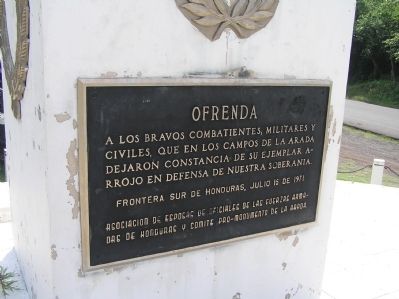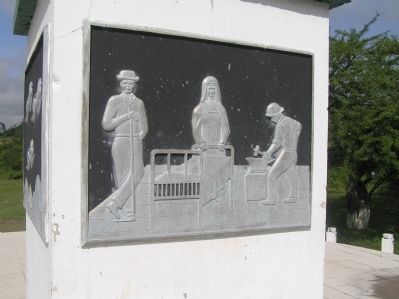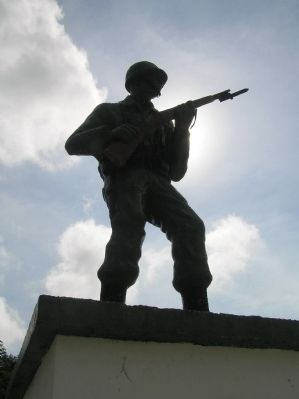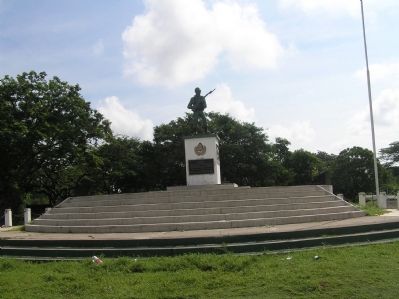Near La Guacimada in Goascorán, Valle, Honduras — Central America
Monument to the Honduran Soldier During the "100 Hours War"
Monumento al Soldado Hondureño
Inscription.
Frontera sur de Honduras, Julio 15 de 1971
Southern Border of Honduras, 15 July 1971
Erected 1971 by Association of Officials' Wives of the Honduran Armed Forces and La Arada Monument Committee.
Topics. This memorial is listed in this topic list: Wars, Non-US.
Location. 13° 35.466′ N, 87° 43.296′ W. Marker is near La Guacimada, Valle, in Goascorán. Memorial is on Pan American Highway (Highway CA-1), on the left when traveling east. The marker is located 3.2 miles (5.1 km) east on the Panamerican Highway after El Amatillo/Goascoran border crossing between El Salvador and Honduras. Touch for map. Marker is in this post office area: La Guacimada, Valle 52101, Honduras. Touch for directions.
Regarding Monument to the Honduran Soldier During the "100 Hours War". Honduras was invaded militarily by El Salvador during July 14-18, 1969 as part of the so-called “100 Hours War” or “Soccer War”. This monument pays tribute to the Honduran military and civilians that lost their lives in southern Honduras during this action.
In the years prior to the invasion, many thousands of Salvadorans had moved to Honduras seeking greater economic opportunities. These Salvadorans in Honduras were often blamed by Honduran authorities for different social and economic ills. In April 1969 Honduras began a series of agrarian reforms which excluded foreigners, leading to the deportation of many of these Salvadoran immigrants. While the issue was being discussed at the Organization for American States, El Salvador invaded Honduras on July 14, 1969. Although the surprise attack allowed Salvadoran forces to initially advance into Honduras, a stalemate arose as Honduran military forces reacted to the invasion. A cease fire was agreed to on July 18, 1969. Salvadoran forces remained in Honduras for some months and a peace treaty was finally signed in October 1980. Final International Court of Justice rulings related to the conflict eventually gave small disputed areas along the border to Honduras.
This
conflict had wide ranging implications in Central America. Approximately 6,000 people were directly killed in the conflict, including both military and civilians. The majority of these were Hondurans. Trade was disrupted for years to come between the countries and the fledgling Central American Common Market became unworkable. Somewhere between 60,000 to 130,000 Salvadorans were expelled from Honduras and many on both sides of the border were forced to move from their homes. The expulsion of Salvadorans from Honduras only worsened social issues in El Salvador and potentially being among the causes of future internal strife and conflict.
In terms of the historical marker, even with the seriousness of the issue being commemorated, it is interesting to note that the marker makes no mention of the conflict itself or El Salvador, preferring instead to commemorate only the Honduran defense of its sovereignty.
Also see . . . The Football War. Wikipedia entry. (Submitted on August 18, 2020, by Larry Gertner of New York, New York.)
Credits. This page was last revised on January 25, 2022. It was originally submitted on November 7, 2013, by J. Makali Bruton of Accra, Ghana. This page has been viewed 1,840 times since then and 25 times this year. Photos: 1, 2, 3, 4. submitted on November 7, 2013, by J. Makali Bruton of Accra, Ghana. • Andrew Ruppenstein was the editor who published this page.



